Imagine relaxing barefoot on a wooden floor—warmed evenly from beneath, using up to 15% less energy than old-school radiators. Underfloor heating under wooden floors isn't just possible—it's transforming homes with comfort and savings. In this detailed guide, you'll discover everything necessary for making an informed, confident decision on integrating underfloor heating under wooden floors into your property. Don’t let worries about compatibility or installation hold you back; the right approach ensures stylish, cozy living that’s efficient, future-proof, and friendly to your wallet.
Underfloor Heating Under Wooden Floors: Unveiling the Possibilities
For anyone seeking a seamless blend of contemporary comfort and timeless natural charm, underfloor heating under wooden floors means enjoying the best of both worlds. Modern heating systems, tailored for wood flooring, disperse warmth consistently for a cozy environment while enhancing energy efficiency. As more homeowners and renovation experts look for clean, sustainable ways to heat homes, this innovative solution is soaring in popularity—offering design versatility and that luxurious, barefoot-friendly feeling year-round.
But can these advanced systems really work beneath engineered wood or solid wood flooring? Absolutely—when the project is expertly managed. From renovated period properties to new builds, both electric and water-based underfloor heating are now carefully engineered to meet the needs of different wood floor types. Adaptations—like floor thickness, species selection, and smart thermostatic controls—make installing underfloor heating under wooden floors as practical as it is appealing. By understanding which products and practices are best, you ensure lasting warmth, minimal maintenance, and maximum value for your investment.
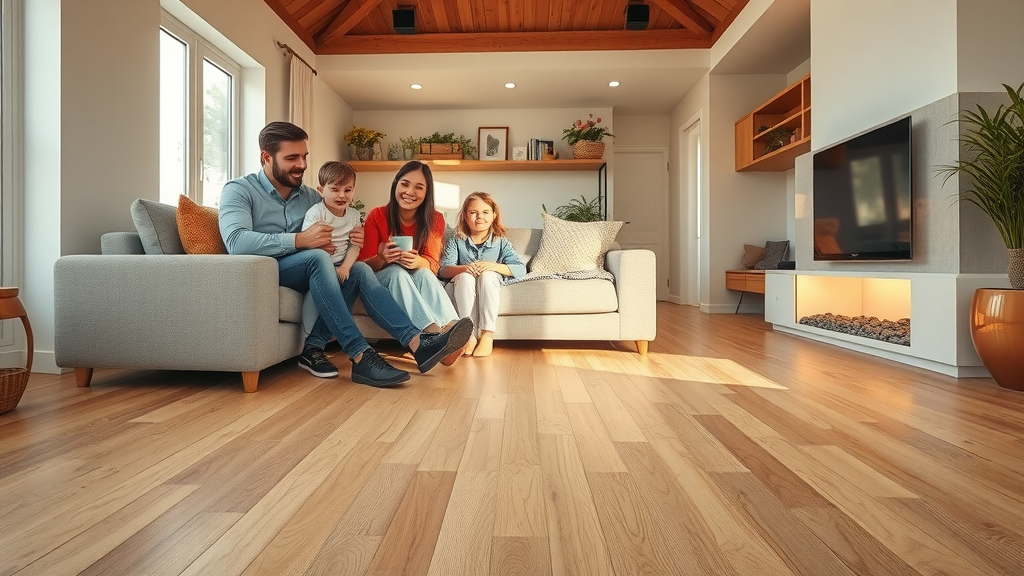
‘Did you know that high-performing underfloor heating systems can cut energy use by up to 15% compared to traditional radiators—even under wooden flooring?’
What You’ll Learn About Underfloor Heating Under Wooden Floors
- How underfloor heating works with various wood floors
- Which wooden floors are compatible with underfloor heating systems
- Best practices for installation
- Pros and cons unique to wood flooring applications
- Frequently asked questions and real-world insights
The Basics: How Does Underfloor Heating Work Under Wooden Floors?
Underfloor heating under wooden floors operates by providing gentle, radiant warmth that rises from beneath the flooring—as opposed to moving heated air through wall-mounted radiators. The system sits below the wood surface, making it both invisible and free from dust-stirring convection currents. Homeowners love the even heat, improved air quality, and uncluttered aesthetics this creates. Whether your property is a new build or an older home, today’s floor heating technology comes in two main types: electric underfloor heating and water-based (hydronic) underfloor heating systems.
The process begins by assessing the type of wooden floor involved. Not all wood flooring is created equal—engineered wood’s stable layered structure is ideal, while solid wood and hardwood flooring require extra attention to thickness, grain, and expansion. With smart thermostats and precise temperature controls, modern underfloor heating systems ensure the flooring never overheats, minimising warping risks. This careful integration offers ongoing comfort, low running costs, and a beautiful finish that’s a world away from clunky radiators and chilly toes.
Exploring Underfloor Heating System Types: Electric and Water-Based Options
Electric underfloor heating (also known as "dry systems") relies on electric cables, mats, or foil installed directly beneath the wooden floorboards. These systems excel in renovations due to their slim profile and quick installation—perfect for retrofitting existing rooms. The alternative, water-based underfloor heating systems (or "wet systems"), circulate warm water through flexible pipes beneath the wood flooring. While wet systems usually demand a bit more floor height and planning, they're incredibly efficient over large spaces, especially for new build projects or significant home remodels.
When choosing between electric underfloor heating and water underfloor heating, consider factors like the size of your space, typical usage patterns, and whether the system will be the primary or supplemental heat source. Both types can work beautifully under the right wooden floors—offering instant comfort and significant energy savings compared to traditional emissions-heavy radiators. Your heating system provider should recommend the best type, tailored to your wooden flooring and property layout.
Engineering Compatibility: Engineered Wood vs Solid Wood Flooring
The key to reliable underfloor heating under wooden floors lies in the wood type. Engineered wood flooring, constructed with a plywood or HDF core and real timber veneer, has exceptional dimensional stability. Its "sandwich" structure helps it withstand temperature and humidity shifts caused by floor heating—reducing the risk of warping or gaps. In contrast, solid wood flooring (whether oak, maple, or other hardwood) expands and contracts more dramatically, which may cause distortion if heat isn’t managed correctly.
Manufacturers and experts widely recommend engineered wood floors for floor heating due to this resilience and the wide range of attractive finishes available. If you prefer the authenticity of a solid wood floor, it’s essential to work with narrower boards and stable species, keep plank thickness within manufacturer-specified limits, and ensure the boards are well-acclimated before installation. With expert guidance, both engineered wood and solid timber flooring can deliver warmth and lasting beauty.
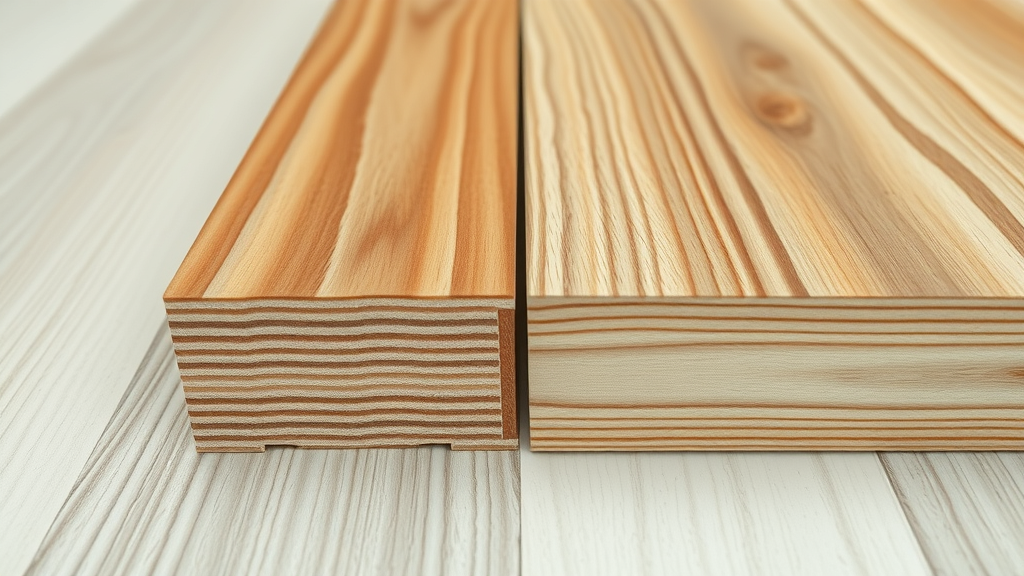
Impact on Floor Height and Room Design with Underfloor Heating
Incorporating underfloor heating under wooden floors can slightly raise your floor height compared to traditional heating. Both electric and water systems add a build-up—electric mats can be less than 5mm thick, while water-based pipes and manifolds may increase height by 20–50mm, particularly with required insulation. This modest increase is manageable with careful planning, but it does influence door clearances, skirting boards, and transitions to adjoining rooms.
Choosing the right system is vital to keeping floor height changes minimal, especially in sensitive renovations. Architects, floor fitters, and underfloor heating specialists work together to integrate the build-up seamlessly into your interior design. The result? A sublime, barrier-free look that pairs beautifully with both classic and contemporary wooden flooring—delivering maximum comfort and a sense of luxurious spaciousness.
Is Your Wooden Floor Suitable for Underfloor Heating?
Not every wood floor is equal when it comes to underfloor heating. Timber's natural characteristics—such as its density, moisture content, and thickness—determine how well it will absorb and transmit gentle radiant heat. The most successful projects start with a careful review of your flooring's specifications, whether you're installing new boards or upgrading existing wooden floors. Tailoring the system to your specific floor type ensures long-term stability, beautiful results, and the safety of your investment.
While the vast majority of engineered wood floors are fully compatible with underfloor heating systems, some very thick or unusually wide solid wood flooring options require expert advice. The right choice depends on plank construction, finish, and installation environment. By understanding these nuances—and partnering with a seasoned installer who prioritises compatibility and performance—you’ll maximise warmth, longevity, and that unbeatable tactile appeal of timber beneath your feet.
Wood Floor and Wooden Flooring: Factors for Underfloor Heating System Success
The interaction between wooden flooring and underfloor heating relies on four main factors: thermal conductivity, thickness, moisture content, and finish. Engineered wood is prized for transmitting heat effectively without suffering expansion or shrinkage. For both engineered and solid wood floor installations, the target thickness is typically 14–20mm—balancing structural strength and heat responsiveness. Unsealed or unstable wooden floors risk absorbing excess moisture or overheating, so always opt for a pre-finished, suitable product from a reputable flooring brand.
Be mindful of the type of wood you choose, as denser hardwoods and multi-layered planking perform best. Avoid flooring with uneven density, excessive knots, or poor stability, as these characteristics may compromise heating system efficiency and lead to movement or gapping. Test runs and moisture measurements before and after installation are crucial—a small step for remarkable peace of mind over your floor heating investment.
Engineered Wood Flooring vs Solid Wood for Floor Heating Performance
Engineered wood flooring stands out for its predictable response to heat. Its cross-layered core minimises movement, giving you an attractive, durable surface with impressive heat transfer. Solid wood, while loved for its authenticity, can expand, contract, or even crown when exposed to changing thermal conditions—it’s less forgiving, especially with wider planks or variable humidity. Unless you're set on a solid wood floor, engineered planks are typically the best option for underfloor heating projects, recommended by leading brands and heating system suppliers alike.
If you do choose solid timber, prioritise narrow, stable boards, ideally no thicker than 18mm. Adhere strictly to temperature guidelines, and acclimate the timber in your home environment for several days pre-installation. This attention to detail helps safeguard your new wooden flooring against movement and extends the lifespan of both the floor and the heating system beneath.
Underfloor Heating System Requirements: Thickness, Finish, and Floor Types
Every underfloor heating system comes with explicit guidelines for compatible flooring thickness and finishes. Engineered wood floors between 14–20mm guarantee a rapid, efficient transfer of radiant heat. Planks exceeding 22mm can stifle performance, leading to slow warm-up times, cold spots, or excessive running costs. Pre-finished boards with a sealed base are best for protecting against moisture ingress, while oil or lacquer finishes provide a resilient, attractive surface for years to come.
Flooring manufacturers and heating kit providers list approved timber species and finish types, since certain hardwoods and poor-quality finishes may not tolerate sustained gentle heat. Always check that both the wood and the underfloor heating system are fit for purpose—don’t hesitate to contact us at Peak Underfloor Heating Ltd for recommendations and a tailored assessment of your space.
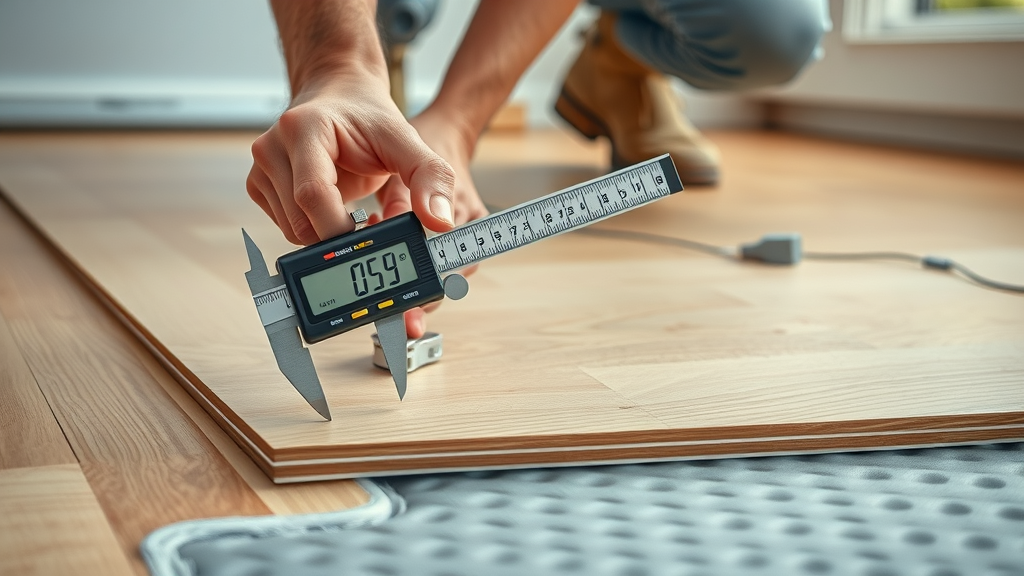
The Pros and Cons of Underfloor Heating Under Wooden Floors
| Feature | Engineered Wood Flooring | Solid Wood Flooring |
|---|---|---|
| Dimensional Stability | Excellent—rarely warps or expands | Variable—prone to expansion and contraction |
| Maximum Recommended Thickness | Up to 20mm | No more than 18mm |
| Heat Transfer (Thermal Conductivity) | Very Good | Good, but can be slower |
| Maintenance Risk | Low | Medium to High if humidity/heat unmanaged |
| Appearance | Wide range of species and finishes | Natural, traditional look |
| Cost | Generally lower than full-thickness hardwood | Typically higher for premium species |
- Energy efficiency: Underfloor heating and wood floors cut energy use versus radiators.
- Enhanced comfort: Consistent warmth, no cold spots, and silent operation.
- Design freedom: No radiators, just free, uncluttered wall space for a modern look.
- Heat-up times: Engineered wood heats up fastest; thicker solid planks slow response.
- Risk of warping or expansion: Reduced for engineered wood, but higher for wide/thick solid wood floors if poorly specified or maintained.
Step-by-Step Guide: Installing Underfloor Heating Under Wooden Floors
Assessing the Existing Wooden Floor and Heating Systems
Before diving into installation, assess both the current wood flooring and any existing heating systems. Look for signs of moisture, unevenness, or gaps which could reduce system efficiency later. Older solid wood floor or hardwood floor installations may need repair or replacement before integrating underfloor heating. For retrofitting, ensure the subfloor is dry, level, and free from debris. This first step sets the groundwork for a trouble-free install that maximises the efficiency of your floor heating investment.
Next, decide if you’ll be replacing or overlaying your wooden floor. Check board thickness and confirm it falls inside manufacturer guidelines. If the existing floor doesn’t meet recommended standards, replacing it with engineered wood may be the best solution. System experts can measure the floor’s moisture content with digital tools, verifying long-term compatibility with the prospective underfloor heating system.
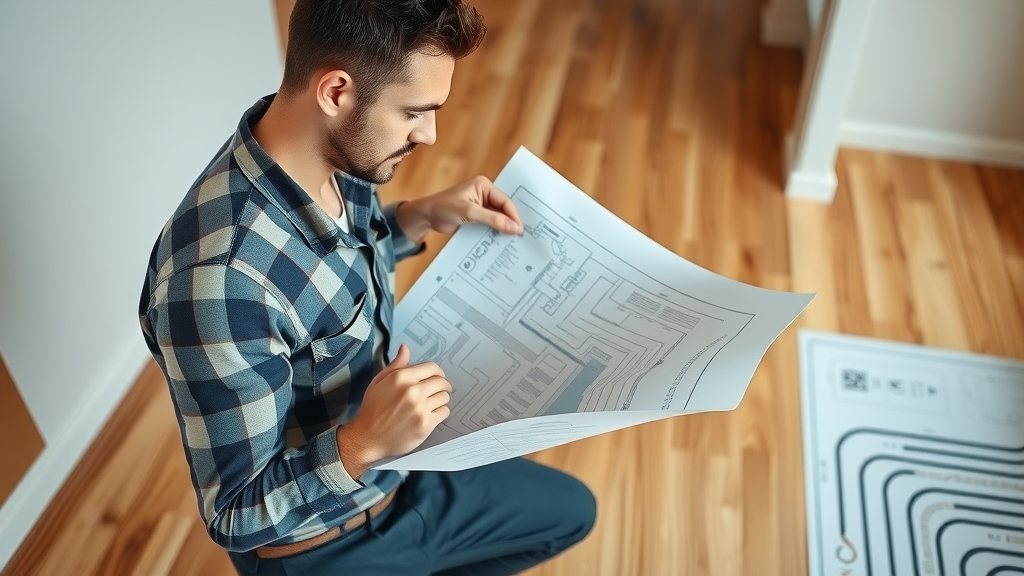
Preparing for Installation: Selecting an Underfloor Heating System for Wooden Floors
With the floor assessed, choose the most suitable underfloor heating system for your home. Water-based systems often work best for larger spaces or where radiant heat will be the primary source, while electric underfloor heating is ideal for single rooms or rapid retrofits. Prioritise systems that offer advanced thermostatic controls, moisture and temperature sensors, and clear compatibility documentation for wooden floors. Make sure the system’s heat output matches the thermal properties of the wood you’ll be installing.
Insulation is critical: install a high-quality insulation layer beneath the heating system to prevent heat loss and improve response times. Coordinate with your installer and flooring provider to check that your chosen products—engineered wood floors, underlays, adhesives, and subfloors—are all certified as appropriate for heated applications. Up-front planning helps safeguard your project against costly errors and prolongs both comfort and floor life.
Installation Process and Tips for Floor Heating and Wood Flooring
Begin by preparing the subfloor—level, dry, and free of debris or old adhesives. Lay insulation boards, followed by the electric underfloor heating mats or water-based pipes, following manufacturer guidelines. A layer of damping material may be applied to prevent vibration and noise. Test the system before sealing it under the final wood flooring—this confirms performance and allows for quick corrections. Next, carefully acclimate your wood for several days and inspect each plank for flaws before laying. Engineered wood boards are typically fixed as a floating floor or lightly glued, depending on subfloor and design; solid wood may require secret nailing or specialist adhesives.
Top installation tips include working at recommended room temperatures, spacing boards to allow for expansion, and using a thermostat to control maximum surface temperature. Avoid rushing the process or ignoring acclimatisation—these steps preserve both heating system performance and your floor's elegant finish. Once complete, follow manufacturer advice on initial system "ramp-up" to help wood adjust gently to radiant heat.
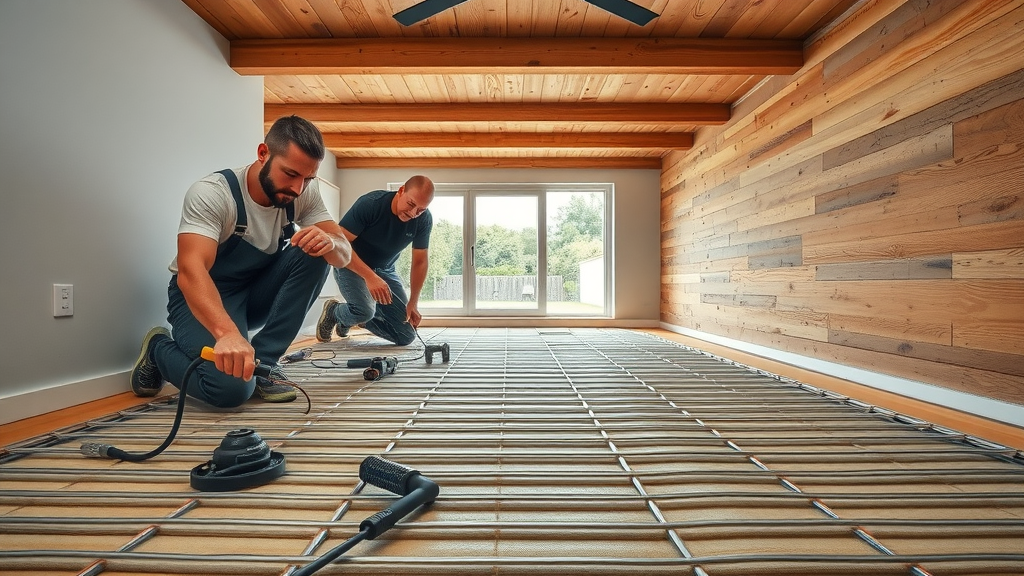
People Also Ask: Underfloor Heating Under Wooden Floors
Can you put underfloor heating under a wooden floor?
Yes, underfloor heating can often be installed under a wooden floor, especially if the flooring is engineered wood, which tolerates heat and humidity changes. Solid wood floor can also be suitable, but careful product selection and installation are critical for optimal performance and longevity.
What is the downside of underfloor heating?
Disadvantages may include a higher upfront cost, slower response time (especially with thick solid wood floors), and potential risk of warping if unsuitable or incorrectly-installed wood flooring materials are used.
What flooring is not suitable for underfloor heating?
Very thick solid wood, unsealed wood, or warped/poorly fitted wooden flooring are generally not recommended. Carpets and some types of vinyl flooring may also hinder heat transfer, making them problematic above underfloor heating.
Can you put in floor heating under hardwood?
Yes, but engineered hardwood is typically preferred for its dimensional stability. If opting for solid hardwood flooring, choose narrow boards and stable species, follow the manufacturer’s temperature guidelines, and consider acclimating wood before installation.
Expert Insights and Best Practices for Underfloor Heating Under Wooden Floors
‘Peak Underfloor Heating Ltd recommends engineered wood flooring for optimal heating system performance over wooden floors—ensuring comfort and longevity for homeowners.’
Industry experts agree: engineered wood flooring offers the best mix of warmth, durability, and trouble-free long-term performance over underfloor heating. Their advice is clear—always use products approved by both the wood flooring and heating manufacturers, insist on insulation, and invest in professional installation. These best practices avoid classic pitfalls and guarantee that your floor looks—and feels—wonderful for decades.
Key Takeaways: Maximising Comfort, Efficiency, and Style
- Underfloor heating under wooden floors is both possible and beneficial when done right
- Engineered wood flooring is most compatible with modern heating systems
- Professional installation is key to long-lasting results
- Advising with experienced specialists like Peak Underfloor Heating Ltd ensures a tailored and reliable solution
Frequently Asked Questions: Underfloor Heating Under Wooden Floors
How long does it take to install underfloor heating under a wooden floor?
Professional installation typically takes 1–2 days for a single room with electric underfloor heating under engineered wood flooring; larger or water-based systems may require several days, especially when including screed drying times and acclimatisation periods.
Does underfloor heating save money in the long run for wooden floor properties?
Yes, underfloor heating under wooden floors can lower running costs due to its even heat distribution and reduced temperature requirements. Over time, this results in significant savings compared to traditional radiators—especially when paired with modern insulation and control systems.
Will underfloor heating work with parquet or herringbone flooring patterns?
Absolutely—underfloor heating is compatible with parquet, herringbone, and other patterned engineered wood floors, provided the wood is within recommended thickness and properly installed. Patterns look stunning, and the heating delivers consistent warmth throughout.
Conclusion: Choose Peak Underfloor Heating Ltd for Underfloor Heating Under Wooden Floors
Investing in underfloor heating under wooden floors adds value, efficiency, and comfort to your property—choose expertise and peace of mind. Contact Peak Underfloor Heating Ltd today for a tailored consultation and flawless installation.
Sources
- Energy Saving Trust – https://www.energysavingtrust.org.uk/advice/underfloor-heating/
- National Wood Flooring Association – https://www.woodfloors.org/underfloor-heating-with-wood-floors/
- Peak Underfloor Heating Ltd – https://peakunderfloorheating.co.uk/
Integrating underfloor heating beneath wooden floors is not only feasible but also offers enhanced comfort and energy efficiency. For a comprehensive understanding of this integration, consider the following resources:
-
“Can you have underfloor heating with wood floors?” (idealhome.co.uk)
-
“Underfloor Heating with Timber Floors” (warmup.com)
These articles provide detailed insights into the compatibility of underfloor heating systems with various types of wooden flooring, offering practical advice on installation techniques and maintenance considerations. If you’re serious about achieving a warm and inviting wooden floor environment, these resources will equip you with the necessary knowledge to make informed decisions.
 Add Row
Add Row  Add
Add 









Write A Comment